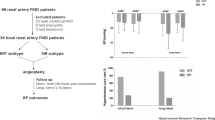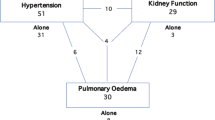Abstract
Renal artery stenosis causes kidney ischemia, reducing the size of the affected kidney, which eventually results in atrophy. Although renal atrophy is considered irreversible, resolution of the ischemia occasionally restores kidney size when the cause is renal artery stenosis. Angioplasty is effective in patients with nonatherosclerotic renovascular diseases (non-ARVDs). Nevertheless, renal enlargement after angioplasty has not been fully examined. We conducted a retrospective study to examine this phenomenon in non-ARVD patients. Ten patients with a <100-mm pole-to-pole length of the poststenotic kidney were treated with angioplasty. Data were collected up to 12 months after angioplasty. The mean age was 28 years; the estimated glomerular filtration rate was 92 ± 7 mL/min/1.73 m2 (mean ± SEM); blood pressure was 150/99 mmHg; 80% were women; and fibromuscular dysplasia was present in 90% of the patients. All patients had hypertension. The lengths of the poststenotic and contralateral kidney before angioplasty were 91 ± 1 and 111 ± 3 mm, respectively. After angioplasty, the length of the poststenotic kidney gradually increased during the 3 months after treatment (+5.4 mm) and that of the contralateral kidney decreased over the same time course (−3.7 mm). Enlargement was also found in the moderate atrophy subgroup (length < 92 mm), and it was greater in the <30 years old group. In a noteworthy case, renal size in the poststenotic kidney recovered from 87 to 102 mm after angioplasty. Our findings demonstrated that reduced renal size can be reversed after optimal angioplasty in non-ARVD patients, especially young patients, suggesting reversibility of the ischemic kidney.
This is a preview of subscription content, access via your institution
Access options
Subscribe to this journal
Receive 12 print issues and online access
$259.00 per year
only $21.58 per issue
Buy this article
- Purchase on Springer Link
- Instant access to full article PDF
Prices may be subject to local taxes which are calculated during checkout





Similar content being viewed by others
References
Dworkin LD, Cooper CJ. Clinical practice. Renal-artery stenosis. N Engl J Med. 2009;361:1972–8.
van Twist DJL, de Leeuw PW, Kroon AA. Renal artery fibromuscular dysplasia and its effect on the kidney. Hypertens Res. 2018;41:639–48.
Mishima E, Suzuki T, Seiji K, Akiyama Y, Ota H, Hashimoto J, et al. Selective embolization therapy for intrarenal artery stenosis causing renovascular hypertension: efficacy and follow-up renal imaging. J Clin Hypertens. 2017;19:1028–31.
Mishima E, Suzuki T, Ito S. Selection of patients for angioplasty for treatment of atherosclerotic renovascular disease: predicting responsive patients. Am J Hypertens. 2020;33:391–401.
Trinquart L, Mounier-Vehier C, Sapoval M, Gagnon N, Plouin PF. Efficacy of revascularization for renal artery stenosis caused by fibromuscular dysplasia: a systematic review and meta-analysis. Hypertension. 2010;56:525–32.
Mishima E, Hashimoto J, Akiyama Y, Shima H, Seiji K, Takase K, et al. Impact of small renal ischemia in hypertension development: renovascular hypertension caused by small branch artery stenosis. J Clin Hypertens. 2016;18:248–9.
Cooper CJ, Murphy TP, Cutlip DE, Jamerson K, Henrich W, Reid DM, et al. Stenting and medical therapy for atherosclerotic renal-artery stenosis. N Engl J Med. 2014;370:13–22.
Mishima E, Umezawa S, Suzuki T, Fujimura M, Abe M, Hashimoto J, et al. Low frequency of cervicocranial artery involvement in Japanese with renal artery fibromuscular dysplasia compared with that of Caucasians. Clin Exp Nephrol. 2018;22:1294–9.
Gornik HL, Persu A, Adlam D, Aparicio LS, Azizi M, Boulanger M, et al. First international consensus on the diagnosis and management of fibromuscular dysplasia. J Hypertens. 2019;37:229–52.
Humphreys BD. Mechanisms of renal fibrosis. Annu Rev Physiol. 2018;80:309–26.
Maruyama K, Chinda J, Kabara M, Nakagawa N, Fujino T, Takeuchi T, et al. Successful percutaneous transluminal angioplasty for the treatment of renovascular hypertension with an atrophic kidney. Heart Vessels. 2015;30:274–9.
Imai E, Horio M, Nitta K, Yamagata K, Iseki K, Hara S, et al. Estimation of glomerular filtration rate by the MDRD study equation modified for Japanese patients with chronic kidney disease. Clin Exp Nephrol. 2007;11:41–50.
Akaishi T, Abe M, Miki T, Miki M, Funamizu Y, Ito S, et al. Ratio of diastolic to systolic blood pressure represents renal resistive index. J Hum Hypertens. 2019. https://doi.org/10.1038/s41371-019-0264-1.
Mishima E, Hashimoto J, Akiyama Y, Seiji K, Takase K, Abe T, et al. Posterior reversible encephalopathy syndrome treated with renin-angiotensin system blockade. J Neurol Sci. 2015;355:219–21.
Herrmann SM, Textor SC. Current concepts in the treatment of renovascular hypertension. Am J Hypertens. 2018;31:139–49.
Riser BL, Cortes P, Zhao X, Bernstein J, Dumler F, Narins RG. Intraglomerular pressure and mesangial stretching stimulate extracellular matrix formation in the rat. J Clin Investig. 1992;90:1932–43.
Nishimoto K, Shiiki H, Nishino T, Uyama H, Iwano M, Dohi K. Reversible glomerular hypertrophy in adult patients with primary focal segmental glomerulosclerosis. J Am Soc Nephrol. 1997;8:1668–78.
Vassallo D, Kalra PA. Progress in the treatment of atherosclerotic renovascular disease: the conceptual journey and the unanswered questions. Nephrol Dial Transplant. 2016;31:1595–605.
Chrysochou C, Green D, Ritchie J, Buckley DL, Kalra PA. Kidney volume to GFR ratio predicts functional improvement after revascularization in atheromatous renal artery stenosis. PLoS ONE. 2017;12:e0177178.
Omae T, Masson GM. Reversibility of renal atrophy caused by unilateral reduction of renal blood supply. J Clin Investig. 1960;39:21–27.
Parikh SA, Shishehbor MH, Gray BH, White CJ, Jaff MR. SCAI expert consensus statement for renal artery stenting appropriate use. Catheter Cardiovasc Inter. 2014;84:1163–71.
Watson PS, Hadjipetrou P, Cox SV, Piemonte TC, Eisenhauer AC. Effect of renal artery stenting on renal function and size in patients with atherosclerotic renovascular disease. Circulation. 2000;102:1671–7.
Mochida Y, Ohtake T, Miyashita Y, Ishioka K, Oka M, Maesato K, et al. Long-term clinical outcome of patients with severe atherosclerotic renal artery stenosis after percutaneous transluminal renal angioplasty. Ren Replacement Ther. 2018;4:5.
Hammoud S, Tissier AM, Elie C, Pousset M, Knebelman B, Joly D, et al. Ultrasonographic renal volume measurements in early autosomal dominant polycystic disease: comparison with CT-scan renal volume calculations. Diagn Inter Imaging. 2015;96:65–71.
Acknowledgements
This work was partially supported by the Tohoku University Center for Gender Equality Promotion (TUMUG) Support Project.
Author information
Authors and Affiliations
Corresponding authors
Ethics declarations
Conflict of interest
The authors declare that they have no conflict of interest.
Additional information
Publisher’s note Springer Nature remains neutral with regard to jurisdictional claims in published maps and institutional affiliations.
Supplementary information
Rights and permissions
About this article
Cite this article
Iwasaki, T., Mishima, E., Suzuki, T. et al. Kidney enlargement effect of angioplasty for nonatherosclerotic renovascular disease: reversibility of ischemic kidney. Hypertens Res 43, 1214–1221 (2020). https://doi.org/10.1038/s41440-020-0473-6
Received:
Revised:
Accepted:
Published:
Issue Date:
DOI: https://doi.org/10.1038/s41440-020-0473-6
Keywords
This article is cited by
-
Fibromuscular dysplasia with recurrence after “long-term” following percutaneous transcatheter renal angioplasty: two case reports with a review of 26 patients
BMC Nephrology (2021)
-
Concurrent analogous organ damage in the brain, eyes, and kidneys in malignant hypertension: reversible encephalopathy, serous retinal detachment, and proteinuria
Hypertension Research (2021)



